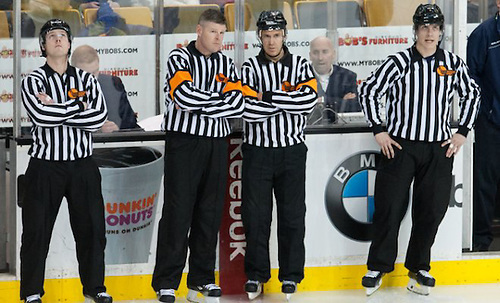
For college hockey fans that may not enjoy the increase in numbers of penalties called early in the college hockey season, there is only one way it will change and that is for players and coaches to adjust.
On a conference call with media Thursday, Steve Piotrowski, secretary of rules for the NCAA and Frank Cole, the national coordinator of officials for the NCAA, noted that the penalties being widely called throughout college hockey are not new rules, but rather a new focus on enforcement.
More importantly, though, players and coaches need to adjust to the new standard of play or else fans can expect to see frequent penalties called.
“We understand that there’s an adjustment period,” said Cole. “When something like this is rolled out, there’s usually a little uptick in penalties in the initial going. But as the weeks go by, we start to see the players are adjusting.
“This is a collaborative effort between the coaches and the officials. It’s something the coaches embraced. We’re working hard with the officials and understand it’s an adjustment for them as well. There are some games that may have been overcalled a little bit in the early going. But we feel comfortable where we are right now. We are seeing it trending in the right direction.”
The standard of play, which was first introduced in 2004 and re-emphasized this season, is an attempt to protect skilled players and allow them to play the game without being illegally interfered with as a way of slowing them down.
“Around 2004, the rules committee really felt the need for a directive to reclaim the rule book, particularly address obstruction and restraining fouls,” said Piotrowski. “Skilled players weren’t being allowed to play and players were using illegal tactics to take away legally-gained advantages.”
Piotrowski said while that initiative and subsequent directives for re-enforcement have worked, additional directives for officials to focus on player safety fouls like contact to the head and hitting from behind led to obstruction and restraint fouls to creep back into the game without proper enforcement.
“What we’d like to do now is to reclaim that rule book again and reset the standard,” said Piotrowski. “To make it simple, we’ve created a number of targeted areas that the ice hockey community can get their arms around.”
Those areas include protecting the puck carrier, to provide a heightened awareness of obstruction on play along the boards and areas that can create restraining and obstruction type of offenses like offensive zone puck dumps and faceoff plays.
One of the biggest aspects of enforcement of the rules seems to focus on body position. The rules committee wants players skating for a puck to be able to do so unobstructed by an opponent’s stick and arms. They want defensive players to use body position to legally prevent the opponent.
In years past, particularly on dump-and-chase plays, officials would use a standard known as “two seconds, two strides.” In other words, a defensive player could make contact with an attacking player who dumps a puck, but must make and release said contact within two seconds and could take no more than two strides.
Now referees are told to enforce a “tight gap” defense, meaning the defensive player can legally make contact with the puck-pursuing player, but must release immediately and failing to do so it a penalty.
“Body position is key for the defending player and body position is really determined by the skating player coming to the front or side of the opponent,” explained Piotrowski.
He also said that officials are taught to look for “red flags” for what turn out to be fouls committed by the defending player.
“If a player is coming through the neutral zone, backchecking very hard, and he is in a desperation mode now, typically, what is he going to do?” asked Piotrowski. “He’s probably going to reach out [with his stick] and that stick is going to become parallel [to the ice].
“When it becomes parallel, that’s a red flag to officials. Now having a stick parallel is not necessarily a penalty, but when it creates a restraining act of tugging an arm or slashing at a hand, that’s an illegal act.”
One of the keys of this initiative moving forward is continued emphasis and consistency among officials. Conference calls with league supervisors will be ongoing and used as a means to check in and receive feedback. But there is also the need for long-term education of players and officials to help manage their approach to games to make reclaiming the rule book an effective initiative.
“It’s not that we’re looking for a rash of penalties,” said Cole. “We’re just looking to re-educate the officials and the players in terms of what’s acceptable and what’s legal play.”
“As far as management going forward, certainly this is an educational process,” added Piotrowski. “If you really think about it from an officiating standpoint, officials will enforce the game in whatever way they are directed to do so. The management of that process has to take place on an ongoing basis.
“At the same time, coaches have to be accepting to the standard of play. It’s going to be a work in progress and it’s going to have to be managed going forward. And everyone is going to have to be onboard, cooperating in all areas: officials, coaches and players.”
Comments are closed.